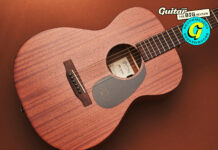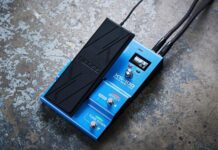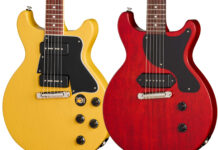
4 weird guitar vibrato systems you probably forgot about
Vibrato systems are often an integral part of an artist’s sound. Some, such as the Bisgby or the Strat’s floating tremolo have stood the test of time as gentle musical additions to electric guitars while others, such as the Floyd Rose, allow much more excessive whammy wanging. Some, however, have not quite caught on for various reasons and in this article, we will take a look at some of the more interesting, options that have come and gone over the years, and some new developments that have come on the market in recent years.
READ MORE: The story of Brian May’s Deacy amp, the little amp that could
Disclaimer: although some companies will use the terms “tremolo” and “vibrato” interchangeably, they are not generally synonymous, as tremolo refers to an alteration in volume, and vibrato is an alteration in pitch. I light heartedly blame Fender for a lot of the confusion. For the sake of sidestepping that confusion in this article we’ll use the two interchangeably.
Steinberger TransTrem
Steinberger TransTrem
This system was rather ingenious. A lot of weird stuff came out of the 80s and this one, although weird, is very functional. When you utilise a typical vibrato bridge, it will adjust the pitch on all the strings at the same time. However, the strings will all stretch at different rates because they are all different sizes. The TransTrem system solved that problem – it can bend each string up or down at different, preset rates, meaning that when you play a chord, you can adjust the pitch of the entire chord or you can have only one string be affected. You can also adjust the vibrato and lock it in, which offers the functionality of a capo. So what was the catch? The system relied on double-ball, calibrated strings in order to bend properly. It was a system designed specifically for the headless Steinberger Guitars and could not be easily adapted to other instruments.
In 2008, Steinberger introduced a new version of the TransTrem on their ZT3 Guitars. The new version allowed you to use standard strings. It also eliminated the need to route the body, making it much more easily applicable to other body styles.
Washburn Wonderbar
Washburn Wonderbar
In the 80s, Floyd Rose and Kahler vibratos were all the rage, but the issue with those is that you had to rout out the body to get the full range of vibrato out of them. The Washburn Wonderbar was an adjustable vibrato that can be mounted to the top of the body with no routing required. These sit up a little higher than a Floyd Rose or stock Fender vibrato, which some people think look unappealing. They eliminated the use of springs, opting for a torsion bar instead. Much like the Floyd Rose, this system needs a locking nut or a roller nut and locking machine heads. You can still find these online.
Gibson sideways Vibrola
Gibson Sideways Vibrola
The Gibson “Sideways” Vibrola was an interesting variant of the standard Maestro Vibrola and is probably one of the more popular versions of a vibrato that is operated with a side-to-side action on the bar. Some people liked the action of this system because the vibrato could be controlled with a motion more closely related to a strumming pattern. It was able to be set up with a lot of range as well. It came out in 1961 and was available on the SG and ES-355 models and could be used with a Tune-O-Matic bridge. It wasn’t incredibly popular, because people claim it wasn’t as smooth to operate as the standard, bar style vibrato systems. But like most systems, it will only be as smooth as the hand operating it.
Palm operated vibrato units
“Palm-O-Low”
Bigsby made a “Palm-O-Low” Bar that screws on in place of the flat bar that is typically used on their standard systems. The bar can then be positioned in a number of ways to fit each player. Ibanez had a device called the U-Bar, which was an optional bar that could be put on the Floyd Rose Seven String Models, it first appeared on the Korn Signature models used by Munky and Head. I’m not sure they ever made one for 6 string versions of the Floyd Rose though. It allowed you to press on the bridge without interfering with the fine tuners on the Floyd Rose. Framus had a very simple design a long time ago [back in the 50s] that seemed to be specifically designed for palm vibrato, but it seemed to be a rather short-lived design, still you can occasionally find them floating around on Reverb or Ebay.
Stetsbar
Stetsbar
The Stetsbar is another vibrato that doesn’t require any additional routing and it has an added bonus of using your pre-existing Tune-O-Matic saddle piece and you don’t have to drill any additional holes in the face of your guitar. Its applications are pretty specific to guitars that once featured the Gibson standard stop-tailpiece. It works pretty well and is a nice option as you can remove it without any evidence of your experimentation if you happen to not like it.
Noted guitar tech and luthier Earnie Bailey uses this bridge on his Wire Instruments Concorde model guitars and I asked him to give me a little info on what makes it unique.
“When you move the vibrato amp up or down, the bridge operates with a linear motion in the same plane as the guitar strings. The bridge plate moves over a pair of linear roller bearings in the base plate, so the bridge and string anchors move as one, eliminating friction over the bridge saddles. The Pro II Stetsbar is equipped with a ‘floating lock’ system. When engaged this keeps the unit in tune if a string breaks, and also allows drop tuning without retuning the entire instrument.
“Stetsbar had a model available that would retrofit onto a Les Paul without routing, and I liked the idea of being able to convert the Concorde from tremolo to stop tail easily as a player option. And since then have switched to the OEM model opting for its permanence, and benefits of attachment directly to the surface.”
The EverTune
The EverTune
Although not exactly a vibrato system in the conventional sense, this system does have a profound effect on string tension, in fact one could even call it an anti-vibrato system. The EverTune is a system that uses springs and levers to ensure that a string never goes out of tune. Depending on how you set it up, you can ensure the string never goes out of tune, even when bending strings. If you haven’t checked these out, I highly recommend playing one. There are several guitarists on tour who don’t even bring a guitar tech anymore because they can use one guitar for an entire show without any worry about having to re-tune.
This system can be set up a few different ways. This video does a good job of explaining the various setup applications.
The drawback of the EverTune is that it is a bit cumbersome and does require that some wood to be removed from your guitar. If you want to use one of these bridges, I highly recommend bringing it to someone who has installed one before.
For more features, click here.
The post 4 weird guitar vibrato systems you probably forgot about appeared first on Guitar.com | All Things Guitar.
Source: www.guitar-bass.net













